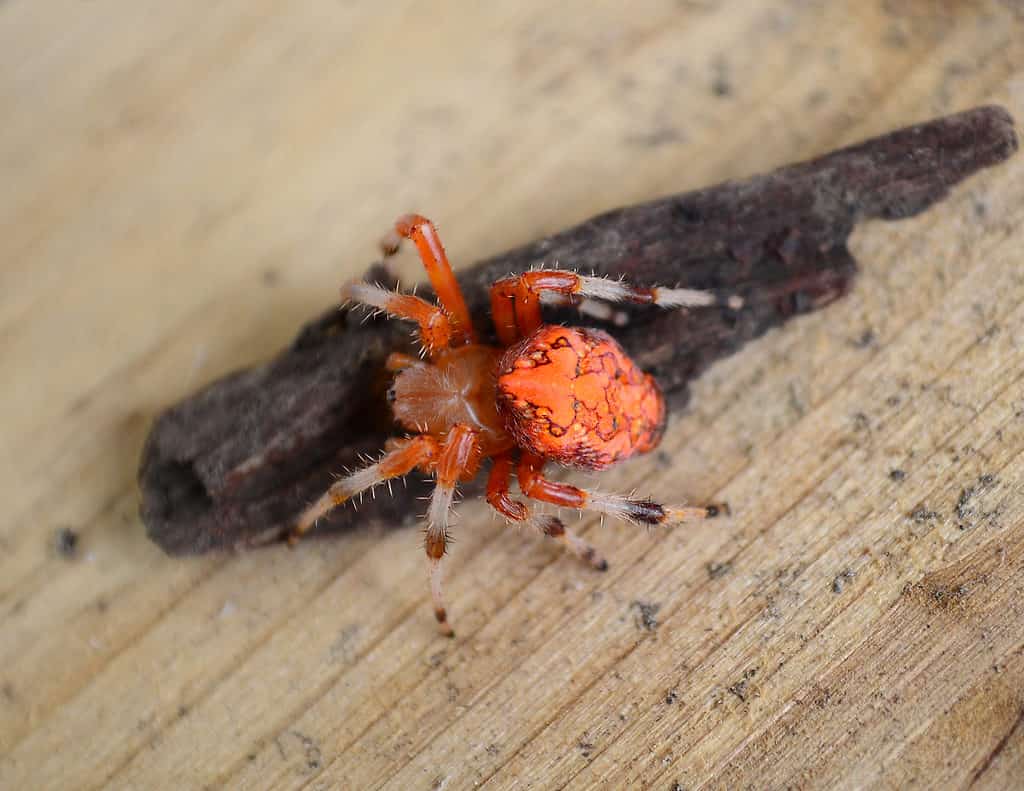Orange Spider
Araneus marmoreus
Orange spiders make vertically-oriented webs for catching prey.
Advertisement
Orange Spider Facts
- Prey
- Insects
- Main Prey
- Insects
- Group Behavior
- Mainly solitary
- Fun Fact
- Orange spiders make vertically-oriented webs for catching prey.
- Most Distinctive Feature
- Orange spiders have large protruding bellies.
- Distinctive Feature
- Black or brown marbling pattern on the spider's abdomen
- Other Name(s)
- Pumpkin spider
- Habitat
- Forests, meadows, agricultural fields, and peat bogs.
- Predators
- Birds, reptiles, and some mammals
- Diet
- Insectivore
- Lifestyle
- Nocturnal
- Favorite Food
- Insects
- Type
- Spider
- Common Name
- Orange spider
- Special Features
- Orange spiders and other orb weaver spiders make unique orb-shaped webs
- Location
- North America and Europe
Orange Spider Physical Characteristics
- Color
- Orange
- Lifespan
- 7–12 months
- Length
- 0.35–0.7 inches
- Venomous
- Yes
- Aggression
- Low
View all of the Orange Spider images!
“Orange spiders make vertically oriented webs for catching prey.”
The marbled orb weaver, popularly known as the orange spider, looks like a pumpkin with legs, thanks to a distinct orange color and inflated abdomen. It is one of the most common garden spiders in North America. The species makes vertically oriented webs on trees, shrubs, and grasses. Araneus marmoreus is a predator with a potent venom for paralyzing prey but rarely attacks humans.
Orange Spider — Species, Types, and Scientific Name
There are several distinct, orange-colored garden spiders. However, the most common orange spider is the marbled orb weaver — Araneus marmoreus. The species is also sometimes referred to as a pumpkin spider because it has an inflated abdomen and a vibrant yellow color.
The marbled orb weaver belongs to the Araneidae family. This is the third largest spider family, with 3,108 species in 186 genera worldwide. Members of this family are known for their circular wheel-shaped webs that they make in forested areas, fields, and gardens.
There are two main varieties of marbled orb-weaver spiders in the world. The most popular one is the orange spider with an inflated orange abdomen and black or brown marbling. The second variety is the pyramidatus. This spider has a paler orange color and may sometimes be white. Instead of marbling, it has a single patch on its abdomen.
Both varieties are rarely seen in the same location, with the pyramidatus being more common in Europe, while the Araneus marmoreus is more common in North America.
Orange Spider Appearance — How to Identify Orange Spiders

Orange spiders have a yellowish orange inflated, pumpkin-like abdomen.
©iStock.com/earlydawnphotography
The most prominent part of this spider’s appearance is the yellowish orange inflated, pumpkin-like abdomen. Some can be dark orange, and others can be plain yellow. It is not an exaggeration to say that it is one of the most brightly colored, attractive spiders in the world.
As with most spider species, females are usually two to three times bigger than males and have the most striking appearance. Size measurements for females vary between 0.35 and 0.7 inches in length and 0.09 and 0.18 inches in width. Males, on the other hand, are between 0.35 and 0.39 inches long, with a width of 0.09 to 0.1 inches.
Orange spiders are known for their large, inflated abdomen. The most common form of this spider has an orange abdomen with black or brown markings. However, the color and patterns may vary slightly from one individual to the other. They have a yellow-to-burnt-orange cephalothorax with dark lines on either side. Their legs are usually bright red with a black and white banding towards the end. In some varieties, the legs have light brown bands instead. The orange spider has distinct black eyes, which tend to be quite sharp.
The spider has a very short lifespan of seven to eight months. Both males and females tend to die after reproduction. The orange spider is non-aggressive and flees from the first sign of threat or trouble. It is mostly solitary until it finds a mate and goes into reproduction. They typically like to spin their webs in the morning and wait for prey at night.
Habitat — Where to Find Orange Spiders
Araneus marmoreus is found in several regions across continental America, eastern Britain, as well as East and Central Europe. It has not been found in northern Ireland yet. It lives in woodlands and spins its web in tall herbaceous vegetation, shrubs, and the lower branches of trees.
Orange spiders also inhabit the Nearctic and Palearctic regions, the Gulf Coast, and the Holarctic regions. Within these areas, you will find them in forests, meadows, agricultural fields, peat bogs, and rivers. They can also be found in man-made places like mailboxes but rarely venture indoors.
The name “orb-weaver spider” is a reference to the unique shape of this spider’s web, which is similar to a wheel. Orange spiders make webs with supporting lines as the main framework. Silk threads attached to the main supporting lines radiate out from the center of the web like the spokes of a bicycle wheel. They may also add some zig-zag patterns to the web. When prey lands in the web, it vibrates to alert the spider.
Orange Spider — Evolution and History
Generally, spiders began their evolutionary journey about 400 million years ago during the Devonian. That’s more than 150 million years before the first dinosaurs arrived on the scene. Scientists believe that the earliest arachnids had a semi-aquatic lifestyle before coming on land fully. The ancestors of present-day spiders were not thin-waisted like today’s varieties. They also had abdominal segmentations, which are absent in modern spiders.
The first true spiders with spinnerets emerged about 380 million years ago. Members of the Mesothelae group (which represents the oldest group of spiders) had their silk-producing organs in the middle of their abdomen instead of at the end like modern day spiders. These spiders were mainly ground-dwelling and lived on the forest floor of the Paleozoic Era. Their diet included other primitive arthropods like cockroaches, millipedes, and silverfish.
Primitive spiders produced silk, but it was mainly an adaptation for protecting their egg and lining their burrows. Later on, they developed the ability to build trapdoors for catching prey.
The use of two-dimensional and three-dimensional webs is one of the most noteworthy adaptations that spiders developed. Scientists think they developed this adaptation as plant and insect life diversified. The development of spinnerets at the end of their body about 250 million years ago allowed the spiders to build more elaborate sheet-like webs for capturing prey on the ground and in trees.
By the Jurassic Period (about 191 to 136 million years ago), flying insects became more abundant. Orb-weaving spiders like the orange spider developed the ability to make sophisticated aerial webs for catching these insects. Scientists are not sure which came first, the horizontally oriented 3D web builders, such as the tent-web spiders, or the 2D web builders, like the orange spider.
Diet — What does it Eat and What Eats it?
What Does the Orange Spider Eat?
Araneus marmoreus is predominantly insectivorous. They feed on insects that they catch in their intricate webbing. Since they are orb-weaving spiders, orange spiders are adept at crafting masterful webs using silky and non-silky strands that wrap around prey as tightly as possible. The web vibrates when it hooks a prey. This alerts the spider to attack and paralyze its prey with venom. Orange spiders then inject digestive fluids into the insects to soften the meat before they start eating. They can catch up to 14 insects in one day using this technique. Some of the insects that make up this spider’s diet include beetles, wasps, moths, and mosquitoes.
What Eats Orange Spiders?
Large arthropods such as scorpions, centipedes, and wasps prey on spiders. Birds and certain reptiles also feed on them.
Prevention
Orange spiders are not harmful to humans. They are aggressive, but their venom is only potent against prey animals. On a human, their venom is not any more dangerous than a bee or wasp sting. They also don’t come into homes, so encounters with humans are few and far between.
Other Spiders That May Be Called Orange Spiders
Aside from the marbled orb weaver, other spiders may also be referred to as orange spiders due to their vibrant orange colors. They include:
- European garden spider — Araneus diadematus
- Woodlouse spider — Dysdera crocata
- Shamrock orb weaver — Araneus trifolium
- Striped lynx spider — Oxyopes salticus
- Orange baboon tarantula — Pterinochilus murinus
- Spotted orb weaver — Neoscona crucifera
- Arrowhead orb weaver — Verrucosa arenata
Related Animals
View all 66 animals that start with OOrange Spider FAQs (Frequently Asked Questions)
Are orange spiders dangerous?
Orange spiders are barely harmful. They are nonaggressive, docile spiders that typically flee at the first sign of a threat or trouble. Although they have venom, it is only dangerous to prey and not harmful to humans.
How many legs do orange spiders have?
Like all spiders, pumpkin spiders have four pairs of legs. Their long legs have a velvety texture which helps them reach and capture prey quickly on their web.
How do you identify orange spiders?
The easiest way to identify this spider is through its orange or yellowish color. However, since many other orb-weaver spiders have this vibrant color, you may look out for other identification signs. One of the most distinctive features of this spider is the unique marbled pattern on its enlarged abdomen.
How do you get rid of orange spiders?
You can make use of essential oils unless you do not appreciate their pungent smell. Citrus powder is effective because spiders, in general, hate citrus. A mixture of half-white vinegar plus water kills orange spiders with a strong scent.
When do orange spiders mate?
Since orange spiders are orb-weaving spiders, it is common to see them mate in late summer. In some other spider species, cannibalism occurs after mating, but this does not happen with the marbled orb weaver.
Do orange spiders live a long time?
Orange spiders live for a relatively short time. They usually live for about a year.
Thank you for reading! Have some feedback for us? Contact the AZ Animals editorial team.
Sources
- wikipedia, Available here: https://en.m.wikipedia.org/wiki/Araneus_marmoreus
- spideridentification.com, Available here: https://spideridentifications.com/marbled-orb-weaver.html
- australian.museum, Available here: https://australian.museum/learn/animals/spiders/spider-facts/
- biokids.edu, Available here: http://www.biokids.umich.edu/critters/Araneus_marmoreus/
















